Solva is a small village in the Parish of Whitchurch, situated on the north of St. Bride’s Bay. The harbour provides a safe, sheltered haven for fishing and leisure vessels, although the fishing trade has now been replaced by the tourist industry. The main Parish War Memorial is situated on Solva Hill, overlooking the bay, whilst the Memorial Hall contains two brass memorials which commemorate the men of the Parishes of Solva and Whitchurch who fell during both World Wars. The hall also contains two further plaques which commemorate the North Pembrokeshire Comrades of the Great War Association, and the original Donors to the Solva Memorial Hall. Many thanks to Les Nixon and Mike Berrell for the photos of the memorials.
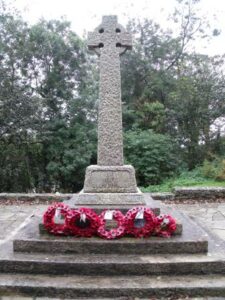
The Great War, 1914-1918
Alfred Allton, Private, 16658, South Lancashire Regiment. Alfred was born in Hereford, the son of Henry and Bridget Allton. The family resided at Llaingama, Solva prior to the war. Alfred enlisted at Carmarthen into the Welsh Regiment on 27 August 1914, with the service number 12838, and using the alias Alfred Holton. He then transferred into the 6th Battalion, South Lancashire Regiment, which was attached to 38 Brigade, 13th (Western) Division. Towards the end of February 1915 the entire Division concentrated at Blackdown in Hampshire, and on 7 June 1915 orders were received to prepare to move to the Mediterranean. On 13 June 1915 the first transports carrying the Division left port, and moved to Alexandria. By 4 July, all units had moved to Mudros, preparatory for landing on Gallipoli. At the beginning of July 1915 the Divisional infantry landed on Cape Helles and relieved the 29th Division. They left and returned to Mudros at the end of the month, and the entire Division landed at ANZAC Cove between 3 and 5 August 1915, taking part in the Battle of Sari Bair. Alfred was killed here on 9 August 1915, aged 21. He is commemorated on the Helles Memorial, Gallipoli.
Thomas Allton, Private, 9609, Royal Welsh Fusiliers. Thomas was the son of Henry Allton, of Llaingama, Solva. He worked as a miner prior to enlisting into the 5th Battalion, Warwickshire Regiment on 1 October 1906, and a year later transferred into the Royal Welsh Fusiliers. He embarked for France with the 2nd Battalion, Royal Welsh Fusiliers in August 1914, and would have served with the battalion during the First Battle of Ypres. At sometime later he transferred into the 17th Battalion, Royal Welsh Fusiliers, which was in France, attached to 113 Brigade, 38th (Welsh) Division. The Division had been in France since December 1915, and had first taken the line near Fleurbaix. In June 1916 the Division marched to the Somme, where it took part in the capture of Mametz Wood in July 1916. After suffering heavy casualties, the Division was moved to Hebuterne, then to positions at the Canal Bank at Boesinghe, north of Ypres. Here the Division took part in the Battle of Pilckem Ridge, and after successfully completing their objectives, were moved to positions at Armentieres to rebuild. Thomas was killed here on 12 November 1917, aged 31. He is buried at Cite Bonjean Military Cemetery, Armentieres, France. Thomas is not commemorated on the Solva memorial.
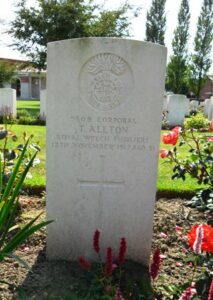
Gwilym Davies. Gwilym cannot presently be identified, but is possibly one of the two men below named William Davies.
John Davies, Gunner, 47937, Royal Garrison Artillery. John was born at Solva, and enlisted at Pentre into the Royal Garrison Artillery. He was posted to their 234th Siege Battery, and moved to France in January 1917, taking up positions near Ypres. John was killed while his battery was taking part in the Battle of Passchendaele on 20 October 1917. He is buried at Vlamertinghe New Military Cemetery, Belgium.
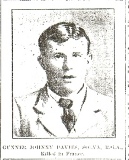
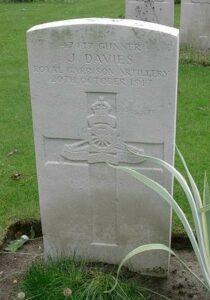
Rhys Brynach Davies, Private, 28828, South Wales Borderers. Rhys was born in 1878, the son of Walter and Anne Davies, of Solva. He married in 1900, and resided with his wife, Florence Louisa Davies, at The Ship Hotel, Solva, where he worked as a bootmaker, and Florence ran the Hotel. Rhys enlisted into the South Wales Borderers after the outbreak of war, and served with the 4th Battalion, South Wales Borderers during the campaign in Mesopotamia. Little else is presently known of him, but Rhys returned home after the war, and died towards the end of 1922, aged 44. Rhys is not commemorated by the CWGC.
William Davies, Private, 10505, Gloucestershire Regiment. William was born at Treorchy, the son of Ann Davies. The family were originally from Solva, and moved back after William’s birth, and resided at New Street, Solva. William enlisted into the Army at Pentre, and was posted to the 7th Battalion, Gloucester Regiment. The battalion formed at Bristol in August 1914, attached to 39 Brigade, 13th (Western) Division. The Division sailed from Avonmouth on 19 June 1915 and landed on Gallipoli on the following month. William was involved in some fierce fighting during his short time at war, and was killed in action at Gallipoli on 8 August 1915. William was 20 years old, and is commemorated on the Helles Memorial, Gallipoli.
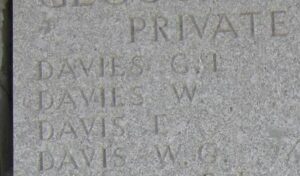
William Davies, Private, 46421, Welsh Regiment. William was the son of Daniel and Dinah Davies, of Carnhedryn Isaf, Solva. Prior to the war he resided with his wife, Annie Davies, at 40, Dew Street, Haverfordwest. He enlisted at Haverfordwest into the 9th Battalion, Welsh Regiment, which moved to France in July 1915 as part of 58 Brigade, 19th (Western) Division. The Division fought during the opening attack of the Battle of Loos, and then moved to the Somme, where they took part in the second wave of the attack on Ovillers-La Boiselle on 1 July, capturing the village at heavy cost, and fought through the Somme Battles of Pozières and the Ancre in 1916. They then moved north to Ypres, taking part in the Battle of Messines, and it was here that William was wounded. He was evacuated to 53 Casualty Clearing Station at Bailleul for treatment, but sadly died there of his wounds on 8 June 1917. William was 36 years old, and is buried at Bailleul Communal Cemetery Extension, France.
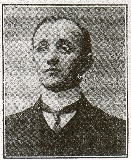
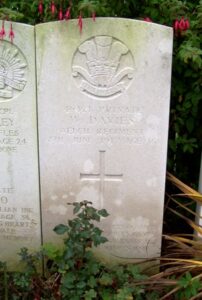
David Evans, Private, 27411, Welsh Regiment. David was the son of James and Martha Evans, of Pentop, Solva, and enlisted at Haverfordwest into the Welsh regiment. After training, he was posted to the 2nd Battalion, Welsh Regiment, which had been in France since August 1914, attached to 3 Brigade, 1st Division. The Division had been one of the first to arrive in France, fighting at the Battle of Mons, and taking part in the retreat to the Marne, where the Germans were stopped. They then fought at the Aisne, and at Chivy, before being moved north to Ypres. Here they fought at the First Battle of Ypres, where they again stopped the German Offensive, before wintering in Flanders, which is where David joined the battalion on 12 May 1915, just after the Battle of Aubers Ridge. David saw his first major action during the Battle of Loos on 25 September 1915, and the subsequent action at the Hohenzollern redoubt. During 1916 the division moved South to the Somme, where they took part in the Somme Offensive. David was killed on 24 August 1916, while the 2nd Welsh were consolidating positions west of High Wood. He was 23 years old, and is buried at Delville Wood Cemetery, Longueval, France.

Thomas Evans, Private, 14089, Welsh Regiment. Thomas was the son of James and Mary Evans, of Bank House, Solva. He was amongst the first men from Solva to enlist, and enlisted at Haverfordwest into the 9th Battalion, Welsh Regiment. The battalion formed part of 58 Brigade, 19th (Western) Division, and moved to France in July 1915. The Division was moved to the Givenchy sector, where it was tasked with a diversionary assault against the Germans during the opening attack of the Battle of Loos on 25 September 1915. Thomas was the first Solva man to fall during the Great War. He was killed on 25 September 1915 when the 9th Welsh made a futile bayonet charge across No Man’s Land, only to be met by machine-gun fire. He was 36 years old, and was buried on the battlefield. His grave was never identified after the war, so Thomas is commemorated on the Loos Memorial, France.

Thomas Henry Evans, Private, 3638, Australian Infantry. Thomas was the son of William and Margaret Emma Evans, of Llaningar Farm, Solva. He emigrated to Australia with his sister Dilys before the war, working there as a farmer at Melbourne. On 6 February 1917, Thomas enlisted at Adelaide into the 50th Battalion, Australian Imperial Force. Thomas embarked at Melbourne on 3 October 1917, and arrived in England on 29 November, marching to camp at Codford St. Mary. On 17 January 1918 he arrived in France, and joined his battalion two days later in the field. The Battalion was on the Somme by April 1918, and was holding the line at Villers-Brettoneux on 27 April, against a strong German attack, when Thomas was hit by a German bullet in his thigh while attempting to rescue a wounded comrade who was entangled in barbed wire. The 50th Battalion alone lost 261 men in three days in the line. Thomas was evacuated to the 25th Field Ambulance, where he was treated before being sent, via the 55th and 5th Casualty Clearing Stations, to hospital at Etretat on 7 May 1918. He suffered for some weeks before succumbing to his wounds on 16 June 1918, aged 30. Thomas is buried at Etretat Churchyard Extension, France. His medals and memorial plaque were sold on Ebay during November 2009.
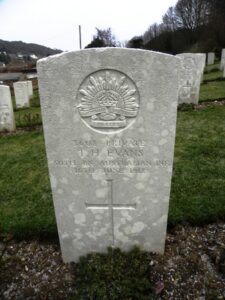
John Griffiths, Lance Corporal, 26088, Welsh Regiment. John was born at Solva, and enlisted at Bridgend into the Welsh Regiment. After training, he was posted to the 17th Battalion, Welsh Regiment, which was attached to 119 Brigade, 40th (Bantam) Division. The Division moved to France between the 1st and 9th June, and moved to the front near Loos. Late in 1916 they moved south to the Somme, and fought at the Battle of the Ancre, and remained in the area over the winter. In March, 1917 the Germans withdrew to their shortened line, called the Hindenburg Line, and the 40th Division were one of the Divisions that followed the withdrawal. John was killed during this stage of the war, on 24 April 1917. He is buried at Fifteen Ravine British Cemetery, Villers-Plouich, France. John is not commemorated on the Solva War Memorial.
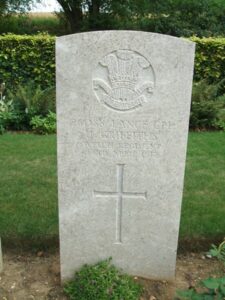
Levi Watkin Griffiths, Private, 53936, Welsh Regiment. Levi was the son of Ebenezer and Catherine Sarah Griffiths, of Vaguer Walter, Solva, and enlisted at Haverfordwest into the 10th Battalion, Welsh Regiment. The battalion trained at Rhyl, and became attached to 114 Brigade, 38th (Welsh) Division. The Division had landed in France during December 1915 and had spent their first winter in the trenches near Armentieres. In June they marched south to the Somme, where they were tasked with the capture of Mametz Wood. The attack on the wood began on 7 July, but met with fierce resistance, and it took until 14 July to totally clear the wood. The Division suffered terrible casualties at Mametz, and were taken out of the line, and moved to Ypres to rebuild. Levi was killed at Ypres on 10 December 1916. He was 23 years old, and is buried at Vlamertinghe Military Cemetery, Belgium. His brother William also fell.
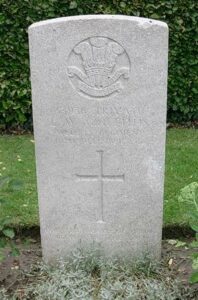
William Lewis Griffiths, Private, 203023, Queens Own (Royal West Kent Regiment). William was the son of Ebenezer and Sarah Griffiths, of Vaguer Walter, Solva, and had originally enlisted into the Monmouth Regiment, with the service number 4317. He later transferred into the 3/4th Battalion, Queen’s Own (Royal West Kent Regiment), which landed in France on 1 June 1917, and was temporarily attached to both 9th (Scottish) Division and 34th Division. On 22 June 1917 the battalion transferred to 51 Brigade, 17th (Northern) Division. The Division was then at Arras, and it was here that William was killed on 24 August 1917. He was 21 years old, and is buried at Sunken Road Cemetery, Fampoux, France. His brother Levi also fell.
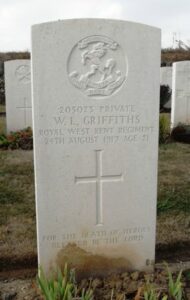
John Elvet Harries, Second Lieutenant, South Wales Borderers. John was born on 1 July 1897, the son of James and Margaret Harries, of Lochmeyler, Pen-y-cwm. He was educated at St. David’s County School and at Cardiff, before he joined the Royal Military College at Sandhurst in 1915. He was gazetted Second Lieutenant in April 1916, and was posted to the 2nd Battalion, South Wales Borderers, which had moved to France from Egypt, attached to 87 Brigade, 29th (Western) Division. John was wounded on the Somme in July 1916, and suffering from shellshock was hospitalised for a while. He rejoined the 2nd SWB at Arras in March 1917, and was killed in action there by machine gun fire on 23 April 1917, aged just 19. John has no known grave, and is commemorated on Bay 6 of the Arras Memorial, France. He is not commemorated on the Solva memorial, but on a private memorial in the Methodist Chapel at Treffynnon.
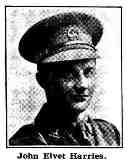
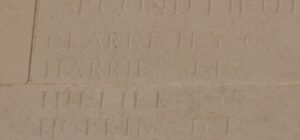
George Everard Hope, MC, Lieutenant-Colonel, Grenadier Guards. George was born at St. George’s, London on 4 November 1886, the son of Henry Walter Hope and Mary Catherine Constance Hope. He was educated at Eton, and was commissioned prior to the war into the 1st Battalion, Grenadier Guards. He married Margaret Cockton at Hanover Square in 1911. At the outbreak of war George landed in France with his battalion, serving as a Lieutenant. He had earned himself the Military Cross for his gallantry, and been Mentioned in Despatches three times, before being promoted to Temporary Lieutenant-Colonel, and given command of the 1/8th Battalion, Lancashire Fusiliers on 21 July 1917. The Battalion was attached to 126 Brigade, 42nd Division. The battalion was then positioned north of Ypres, and took part in the Battle of Passchendaele. George was reported as missing, presumed Prisoner of War on 10 October 1917, but he must have died as a POW on that date, aged 30. George is buried at Ramscappelle Road Military Cemetery, Belgium. Margaret remarried, becoming Margaret Clarke, and resided at Llanunwad, Solva. George is not commemorated on the Solva Memorial.
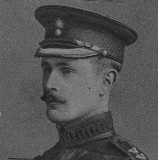
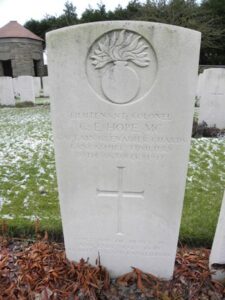
Thomas Jenkins, Steward, Mercantile Marine. Thomas was born at Brawdy in 1865, the son of James and Mary Jenkins. The family was residing at Solva by 1901. Thomas served in the Merchant Navy, aboard SS Forestmoor, a London registered vessel. On 6 October 1917, Forestmoor was on route from Huelva to Dublin with a cargo of copper ore, when she was torpedoed and sunk by the German submarine UB-51, with the loss of 22 lives. Thomas was 53 years old, and is commemorated on the Tower Hill Memorial, London.
Tom John, Stoker I, K27100, Royal Navy. Tom was born at Solva on 30 July 1882, the son of William and Ellen John. He worked as a miner in the Rhondda prior to the war, before enlisting into the Royal Navy on 19 June 1915. Tom trained at HMS Vivid II before being posted aboard the Town-class light cruiser HMS Liverpool on 14 September 1916. Liverpool served in the Adriatic until the end of the war, and upon returning to England, Tom was demobilised on 21 April 1919. He possibly returned to the Rhondda and died in 1929.
Henry Johns, DSC, Master, Mercantile Marine. Henry was born in Solva in 1857, the son of Joseph John and Rebecca John (nee Griffiths). He left home as a young man to join the Mercantile Marine and lodged with an aunt, Mary Powell, in Cardiff. In about 1882, Henry married Sarah Ellen Jones, a schoolteacher from Beaufort, and she set up the family home at 7, Beauford Road, Ebbw Vale. Henry thrived at sea and by 1881 had gained his Masters Certificate at Liverpool, entitled him to be a Ships Captain. By the time war erupted, Henry was Captain of the SS Whitefield. She was shelled and sunk by a German submarine on 1 September 1915, but Henry and all of his crew survived, taking to the ships lifeboats before the ship was sunk. Upon safely returning to Britain, Henry was given command of SS Tantallon, before becoming Captain of the defensively armed merchant steamer, SS Haslingden. Henry was awarded the Distinguished Service Cross for War Services, in the London Gazette of 16 November 1917. On 12 May 1918, Haslingden was approaching the Tyne and was some seven miles east of Seaham Harbour, returning from Rouen, when she was torpedoed without warning and sunk by the German submarine UB-21. The torpedo blew up directly beneath the bridge, hitting the engine room, killing Henry and several other crewmen instantly. Henry was 60 years old when he was killed that day, and is commemorated on the Tower Hill Memorial, London.
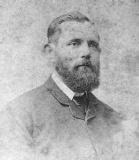
Ernest Johnson, Private, 16036, Gloucestershire Regiment. Ernest was born at Whitchurch in 1893, the son of William and Margaret Johnson. Prior to the war he worked at Roch as a Teamster, and enlisted at Haverfordwest into the 10th Battalion, Gloucestershire Regiment. On 8 August 1915 the Battalion moved to France, where they became attached to 1 Brigade, 1st Division. The Division was a Regular Army Division that had been on the Western Front since the opening Battle of Mons. The 10th Gloucester’s then joined them, and saw their first action during the Battle of Loos and the action at the Hohenzollern Redoubt. The Division was then moved south to the Somme in the summer of 1916, where they fought during the opening of the Somme Offensive at the Battle of Albert. They then saw action at the Battle of Bazentin Ridge, and the Battle of Pozieres Ridge. It was during the terrible fighting that raged around this time that Ernest was killed in action, on 18 August 1916, aged 23. He is buried at Caterpillar Valley Cemetery, Longueval, France.
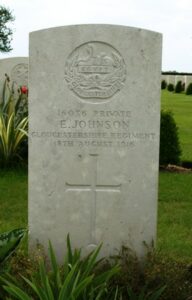
William Donal Morgan, Second Lieutenant, Royal Engineers. William was born at Valpaisaso, Chile on 2 July 1892, the only son of Captain Peter W. Morgan and Mrs Olive Morgan of Bryn-Y-Mor, Solva. William was educated at Cheltenham College prior to the war, and qualified as a Civil Engineer. Upon the outbreak of war he was commissioned into the Royal Engineers, and was posted to the 95th Field Company, which was attached to the 7th Division in France. William was killed in action during the Battle of Loos on 13 October 1915. He was 23 years old, and is buried at Cambrin Churchyard Extension, France.
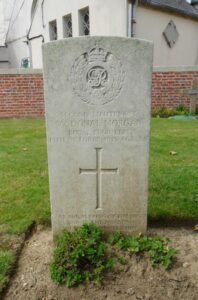
John Morris, Private, 33143, Welsh Regiment. John was the son of Lewis and Elizabeth Morris, of Willow House, Solva, and he lived at Caerau, Glamorgan before the war. John enlisted at Bridgend into the Welsh Regiment. John landed in France on 29 June 1915, joining the 1st Battalion, Welsh Regiment, which was attached to 84 Brigade, 28th Division. The battalion had seen heavy fighting that year, being practically annihilated during April and May 1915 during the Second Battle of Ypres. John joined the battalion at Ridge Wood, near Ypres, where it was rebuilding, in preparation for a move southwards. The Battle of Loos opened on 25 September 1915, and the 28th Division was moved south, taking up the line at Hulluch and Hill 70. John was killed when the battalion was moving into positions at the Hohenzollern Redoubt on 2 October 1915. He was 35 years old, and is commemorated on the Loos Memorial, France.
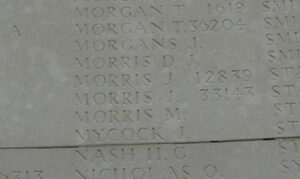
Joseph Charles Neale, Private, 541702, Labour Corps. Joseph was born in 1897, the son of Albert and Hannah Neale, of Mountain Canol, Whitchurch. He served with an Agricultural Company of the Labour Corps. Joseph was invalided with shellshock towards the end of the war and died during the end of 1922, aged 25. Joseph is not commemorated by the CWGC.
Evan Nicholas, First Mate, Mercantile Marine. Evan was born at Mathry, the son of Evan and Elizabeth Nicholas. He served in the Mercantile Marine, and lived with his wife Ruth Adelaide Nicholas (formerly Davies, nee Jenkins), at Kingheriot, Solva. Evan served as First Mate aboard the SS T. R. Thompson, a Sunderland registered steam ship. On 29 March 1918, she was on voyage from Algeria to Middlesbrough, with a cargo of iron ore, when she was torpedoed and sunk by the German submarine UB-57. Three men were saved from her crew of 36, but Evan died in the sinking. He was 69 years old, and is commemorated on the Tower Hill Memorial, London.
Albert William Prance, Private, 54587, Welsh Regiment. Albert was the son of Captain Henry Thomas Prance and Alice Maud Prance, of Penberry, Solva. He worked as a carpenter at St. David’s prior to the war, and enlisted at Swansea into the Welsh Regiment. After training was posted to France to join the 15th Battalion, Welsh Regiment, known as the Carmarthen Pals. The 15th Welsh was part of 114 Brigade, 38th (Welsh) Division, and had been in France since December 1915, and had fought at Mametz Wood and Pilckem Ridge. Albert probably joined the battalion after it had moved to the Somme in April 1918, and was wounded during the 100 days offensive, after the 15th Welsh had forded the River Ancre on the night of 22 August, beginning a drive across the Somme Battlefields which was to ultimately win the war. Albert was in taking part in the advance towards Sailly-Saillisel on 3 September when a shell burst nearby, killing and wounding several men, including Albert. He was evacuated to the Canadian Casualty Clearing Station at Varennes, but died of his wounds there on 7 September 1918. He was 21 years old and is buried at Varennes Military Cemetery, France.
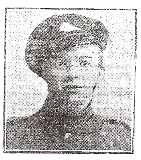
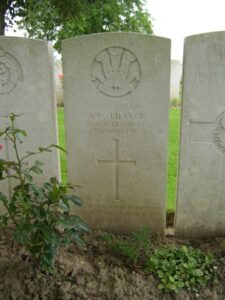
Rees Protheroe, Private, 29294, South Wales Borderers. Rees was born at Solva in 1879. Prior to the war he resided with his wife, Florence Louise Madeline Protheroe, at 18, Cosmeston Street, Cathays, Cardiff. He enlisted at Cardiff into the Army, and was posted to the 2nd Battalion, South Wales Borderers, which had begun the war in China, where they captured the German garrisoned town of Tientsin. The battalion was then recalled to Britain, where it joined 87 Brigade, 29th Division. The Division moved to Gallipoli via Egypt, landing on 25 April, 1915. They remained here until evacuation to Egypt on 11 January, 1916 and then moved to the Western Front on 15 March 1916. Rees probably joined the battalion around this time, on the Somme. The Division took part in its first major action in France during the 1916 Somme Offensive, and fought at the Battles of Albert and Le Transloy, suffering heavy casualties. In the Spring of 1917 they fought at the Battle of the Scarpe, which was part of the Arras Offensive, and then moved further north to Ypres. Rees was killed at Ypres on 5 July 1917. He was 37 years old, and is buried at Bard Cottage Cemetery, Belgium.
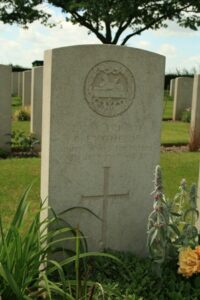
Benjamin Reynolds, Private, 41870, Royal Army Medical Corps. Benjamin was born in 1896, the son of William and Catherine Reynolds, of Wilcox Street, Solva. He was a school teacher prior to the war, and enlisted into the Royal Army Medical Corps at Haverfordwest on 18 October 1914. He served in France with 21 Casualty Clearing Station, RAMC from 26 November 1915 until 28 January 1916, when he was invalided home, suffering from Tuberculosis and Epididymitis. He was discharged from the army on 21 March 1916, and died on 28 May 1917, aged 21. His brother James was killed later that year. Benjamin was accepted for commemoration by the CWGC on Saturday 26 April 2014 as a result of my research.
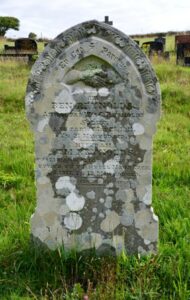
James Reynolds, Private, 28457, Welsh Regiment. James was the son of William and Catherine Reynolds, of Wilcox Street, Solva. He worked as a shop assistant at Haverfordwest prior to the war, and enlisted there on 13 April 1915 into the Welsh Regiment. After training, James was posted to the 18th Battalion, Welsh Regiment, which was attached to 119 Brigade, 40th (Bantam) Division. The Division moved to France during June 1916, and moved to the front near Loos. James was wounded on 6 July, and spent nine months in hospital before rejoining the battalion on the Hindenburg Line. In March 1917 the Germans withdrew to their shortened line, called the Hindenburg Line, and the 40th Division was one of the Divisions that followed the withdrawal. Later in the year they took part in the Battle of Cambrai, playing an important role in the attack on Bourlon Wood. James was killed at Bourlon Wood on 24 November 1917. He was 19 years old, and is commemorated on the Cambrai Memorial, Louverval, France. His brother Ben had recently died at home.
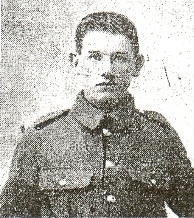
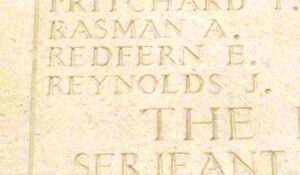
Henry Stephen Roach, Private, 28103, Welsh Regiment. Henry was the son of David and Phoebe Jane Roach, of Brynteg, Solva. He enlisted at Haverfordwest into the Welsh Regiment. After training, Henry was posted to the 18th Battalion, Welsh Regiment, which was attached to 119 Brigade, 40th (Bantam) Division. The Division moved to France during June 1916, and moved to the front near Loos. Late in 1916 they moved south to the Somme, and fought at the Battle of the Ancre, and remained in the area over the winter. In March 1917 the Germans withdrew to their shortened line, called the Hindenburg Line, and the 40th Division was one of the Divisions that followed the withdrawal. Later in the year they took part in the Battle of Cambrai, playing an important role in the attack on Bourlon Wood. They remained in the area over the coming months, but were caught here by the German Spring Offensive of 21 March 1918, and fought there at the Battle of St Quentin and retreating back westwards fought at the First Battle of Bapaume. Due to the terrible casualties suffered by the Division here they were sent north to Flanders to rest and rebuild, but in April the Germans launched an offensive in Flanders, and the 40th Division was caught up in the thick of it again, fighting at the Battle of Estaires. It was here that Henry was killed on 13 April 1918. He was 20 years old, and is commemorated on the Ploegsteert Memorial, Belgium.
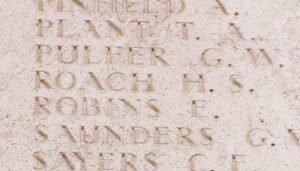
Joseph Rowe, Master, Mercantile Marine. Joseph was born at West Hartlepool in 1881, the son of William Rowe and Caroline Rowe (nee Enderwick). He went to sea as a young man, and later set up home at Nine Wells, Solva, Pembrokeshire. Joseph married Sarah Elizabeth Johns, the daughter of Captain Henry Johns (above), of Caegwyn, Beaufort and Solva at St. David’s Church, Beaufort on 12 June 1914. By the time war erupted, Joseph was Master of the SS Albania, but later served as Master of the SS Bayvoe. He died of a ruptured gastric ulcer at Genoa on 14 May 1918. Joseph is not commemorated as a war casualty by the CWGC. His widow, Sarah, died at Cae Gwyn, Solva on 22 August 1975, after having never remarried.
John Stephens, Gunner, W/2742, Royal Field Artillery. John was the son of Thomas and Elizabeth Stephens, of Llandruidion, Solva, and enlisted at Cardiff into the Royal Field Artillery. He was posted to the ‘Z’, 38th Trench Mortar Battery, which was attached to the 38th (Welsh) Division. The Division moved to France in December 1915, and took up positions near Fleurbaix. They remained in this sector over their first winter on the front, before moving to positions near Givenchy. It was here that John was killed on 16 May 1916, aged 18. He is buried at Royal Irish Rifles Graveyard, Laventie, France.
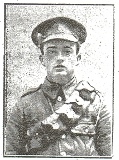
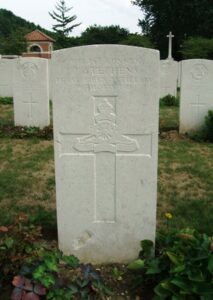
Osborne Richard Thomas, Master, Mercantile Marine. Osborne was born in 1879, the son of William and Sarah Thomas, of Wileor Street, Solva. He had served with the Mercantile Marine for many years prior to the war. From 1917 onwards, Osborne served aboard the SS Quantock, a Cardiff registered steamer. The ship was moored at Nantes on 24 October 1918 when Osborne took ill with influenza. He died on board at Nantes on 27 October 1918, aged 39, and was buried at Nantes the following day. Osborne is not commemorated by the CWGC, as he is not a casualty of war.
Joseph Henry Trowsdale, Private, 40752, South Wales Borderers. Joe was born in Liverpool in 1878, the son of Joseph and Martha Trowsdale. His mother was from Solva, and the family later returned to the village to run the Cambrian Hotel. Joseph enlisted into the Royal Welsh Fusiliers on 18 December 1915, and after training was posted to France, joining the 2nd Battalion, South Wales Borderers. He served with them in France for several months before becoming ill with stomach problems, and was discharged from the army the week before the Armistice. He returned to Solva, where he married Annie, then the couple moved to The Laurels, 3, Berridale Terrace, Grange Over Sands. Joseph struggled with his health until dying on 6 March 1928, aged 49. He is not commemorated as an official casualty of war by the CWGC as his death was so long after the war.
World War Two, 1939-1945
Edward Vaughan Davies, CMG, DSO, OBE, Master, Merchant Navy. Edward was born at Solva in 1882, the son of Daniel and Dinah Davies. He was a Merchant Mariner prior to the war, and married Ruth Jenkins at Cardiff in 1910. At the outbreak of WW1, Edward volunteered to serve with the Royal Naval Reserve, and during his time at war became highly decorated for his gallantry. At some time during WW2, the family moved to Wallasey, Cheshire, where Edward was Captain of the MV Apapa. Apapa gained fame early in the war by helping to evacuate hundreds of Czechoslovak soldiers from France, which led to Edward being awarded the Czech Military Cross. Apapa was sunk by a German Kondor on 15 November 1940, 200 miles off Ireland, but Edward was luckily one of around 20 people who survived the sinking. He then retired, becoming Senior Commander of the Elder Dempster Line, and died at his home in Wallasey, Cheshire, on 7 September 1945, aged 63. Edward is buried at Felinganol (or Middle Mill) Baptist Chapelyard, near Solva, along with his wife Ruth. Their son, Vaughan Davies, was killed earlier in the war.
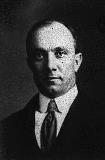
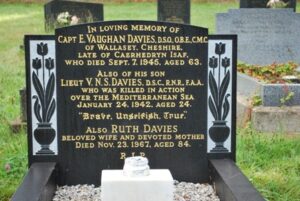
Thomas Walter Davies, Stoker 1st Class, C/KX 80223, Royal Navy. Thomas was the son of William Henry and Blodwen Davies, of Solva, and served in the Royal Navy aboard HM Submarine Tarpon. On 5 April 1940 HMS Tarpon left Portsmouth for Rosyth in company with HMS Severn, and the following day they were ordered to Norway. On 10 April Tarpon was signalled to take up a new position, but she had already been lost. According to German records, Tarpon attacked the Q-ship Schiff, but her torpedoes missed. Schiff then depth charged Tarpon and sank her with the loss of all hands. Thomas is officially listed as being killed on 22 April 1940. He is commemorated on Panel 38 of the Chatham Naval Memorial, Kent.
Vaughan Ninian Startin Davies, DSC, Lieutenant, Royal Naval Reserve. Vaughan was born at Solva in 1917, the son of Edward Vaughan Davies and Ruth Davies. Prior to the war, he married Joan Frances Gwendoline MacIntosh, of Levens, Westmoreland, and the couple had two children. Vaughan followed in his fathers footsteps, and volunteered to serve with the Royal Navy from 1935 onwards. Vaughan served aboard HMS Rodney, HMS Cossack and HMS Aurora, until volunteering to become a pilot with the Royal Naval Air Service in October 1940. He trained at HMS Daedalus, the RN Air Station at Lee-on-Solent, prior to becoming a pilot with 815 Squadron Fleet Air Arm, which was based at HMS Grebe, at Dekheila, near Alexandria, Egypt. Vaughan was then posted to 828 Squadron FAA, On 24 January 1942, Vaughan was flying a Fairey Albacore of 828 Squadron, when it went missing off Benghazi, during a flight from Benghazi to Malta. No more is known of his fate. Vaughan was 24 when he went missing that day, and he is commemorated on the Lee-on-Solent Memorial, Hampshire, and also on his parents grave at Middle Mill, Solva. He was posthumously awarded the Distinguished Service Cross for his work in the Mediterranean, which was presented to his wife. Vaughan is not commemorated on the Solva memorial.

James Alexander Burrows Erskine, Second Engineer Officer, Merchant Navy. James was the husband of Elizabeth Ann Erskine, of Harbour House, Solva. He served with the Merchant Navy aboard the M.V. Adellen, a London registered Motor Vessel. On the morning of 22 February 1942, the German Submarine U-155 fired three torpedoes at the convoy ONS-67, south of Cape Farewell and heard three detonations. Two ships were sunk by the torpedoes, the Adellen and the Sama. James was among 29 men lost in the sinking of Adellen that morning. He was 27 years old, and is commemorated on the Tower Hill Memorial, London.
Vincent Gunner, Private, 14623416, The King’s Own Scottish Borderers. Vincent was the son of Alfred Albert Victor and Martha Jane Gunner, of Penycwm. He joined the army late in 1942, and was posted to India with the 2nd Battalion, King’s Own Scottish Borderers. After undergoing jungle training in India, the battalion sailed with the 7th (Indian) Division to Burma in September 1943. They crossed into the Arakan, and took part in the actions at Ngakydauk Pass. Vincent was killed in action here on 15 May 1944. He was 19 years old, and is commemorated on the Rangoon Memorial, Myanmar.
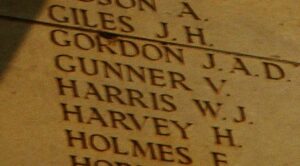
Cecil Moreton Howell, Squadron Leader (Pilot), 70332, Royal Air Force Volunteer Reserve. Cecil was born at Solva in 1915. He served his apprenticeship as an engineer with Metro-Vickers from 1934, and gained a degree in engineering before joining the Royal Air Force Volunteer Reserve, where he was commissioned as a Pilot Officer on 15 December 1936. Cecil was later promoted to Flying Officer at the outbreak of war, and later to Squadron Leader. Cecil served with 106 Squadron, RAF, which was a heavy bomber squadron, equipped with the Avro Lancaster. On the evening of 16 September 1942, Cecil took off as pilot of Avro Lancaster Mk I, Serial W4179 ZN, from RAF Coningsby, as part of a large force bound for Essen. His Lancaster was shot down, and crashed at Soars, in the north-eastern suburbs of Aachen that night. All seven of the crew were killed, and originally buried at Aachen, but after the war the graves were relocated to Rheinberg War Cemetery, Germany. Cecil was 25 years old.
Albert Leonard John, Corporal, 3969337, South Staffordshire Regiment. Albert was the son of Albert Victor and Jennette John, and the Husband of Florence Harries John, of Pembroke Dock. He served with the 1st Battalion, South Staffordshire Regiment, which fought in Burma against the Japanese. Albert died in Burma on 23 June 1944. He was 27 years old, and is buried at Taukkyan War Cemetery, Myanmar.
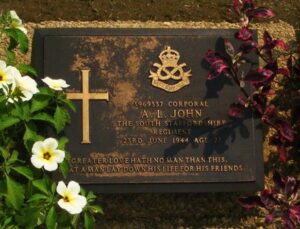
Thomas A. Lamb, Second Engineer, Fishing Fleet. Thomas was the son of William Main Lamb and Mary Ann Lamb, of Vagur Eiln Lodge, Solva. Thomas was a Fisherman, and served aboard the S.S. Ilfracombe, a Lowestoft registered steam trawler. Thomas was killed when Ilfracombe was machine-gunned by a German aircraft on 6 September 1940. The body of the 25-year-old was brought back to land and conveyed to west Wales, where he was buried with full military honours at Llanhowell (St. Hywel) Churchyard. Thomas does not seem to be commemorated locally.
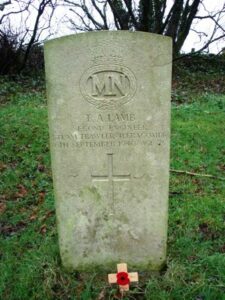
Thomas Morris, Quartermaster, Merchant Navy. Thomas was the son of Ann Morris, of Solva, and served in the Merchant Navy aboard the SS City of Ripon, a Hull registered vessel. On 11 November 1942, the unescorted City of Ripon was about 90 miles of Georgetown, British Guyana, when she was struck by a torpedo from the German submarine U-160. The ship shuddered to a halt, and was struck by a further two torpedoes, and sank with the loss of 56 lives. Thomas was 29 years old when he died that day, and is commemorated on Panel 30 of the Tower Hill Memorial, London.
Gwilym Henry Storkes Prance, DSC, Master, Merchant Navy. Gwilym was the son of George Storkes Prance and Sarah Ann Prance, of Solva. He married Marion Alyce Hardy, at Newport, Gwent in 1935. Gwilym was a long serving Merchant Seaman, and during the last years of WW2 was Master of the S.S. Ocean Gypsy, a Manchester registered steamer. She was in the Indian Ocean after the end of the war when Gwilym took ill. He died on 11 February 1946, aged 50, and is buried in Calcutta (Bhowanipore) Cemetery, Kolkata, India. He was the holder of the Disytinguished Service Cross.
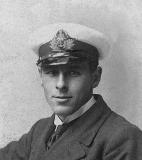
Albert James Preece. Albert was born on 5 December 1914, the son of Albert and Margaretta Preece, of Vachelich, St. Davids. He was a schoolteacher prior to the war. Albert served during the war and died at Denbigh Sanatorium on 1 July 1947, aged 32. Presently his unit cannot be identified.
Gwynfred Ellis Creswell Prickett, 2nd Engineer, Merchant Navy. Gwynfred was the son of George and Elizabeth Ann Prickett. He served with the Merchant Navy aboard the S.S. Nordeflinge, a Cardiff registered steamer. On 30 May 1944, Nordeflinge was on route to Taranto from Cardiff with a cargo of coal, when she was torpedoed and sunk by a German Junkers 88 bomber about 40 miles NE of Algiers. Gwynfred was 28 years old when he died that day, and is commemorated on the Tower Hill Memorial, London.
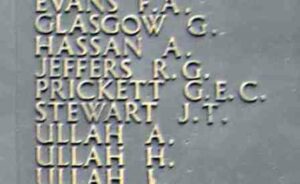
Donal Morgan Prosser, Leading Writer, D/MX103134, Royal Navy. Donal was the son of Major Frank Atkinson Prosser and Olive Prosser. He served with the Royal Navy aboard H.M.S. Mahratta, an M-Class destroyer. Most of her service was spent on convoy escort duty in the North Atlantic. On 11 February 1944, Mahratta sailed from Scotland to escort Convoy JW-57. On 25 February 1944 the convoy was attacked by German Submarines, one of which, the U-990, fired two torpedoes at Mahratta, which exploded and sank, with the loss of 220 lives. Donal was 21 years old when he died that day, and is commemorated on the Plymouth Naval Memorial, Devon.
Clifford Benjamin Reynolds, Able Seaman, D/SSX 20595, Royal Navy. Clifford was born on 15 May 1920 in Solva, the son of Dai and Martha Reynolds (nee Jenkins). He was 22 years old when he married Winnefreda in January 1941, and had enlisted in the Royal Navy in 1937. After several postings, Clifford joined the crew of HMS Prince of Wales in January 1941. Prince of Wales was one of the Royal Navy’s most modern battleships, and on 25 October 1941 left the Clyde with HMS Repulse, bound for Singapore via the Cape of Good Hope, arriving on 2 December. On 10 December 1941, Prince of Wales and Repulse were attacked by Japanese aircraft in the Pacific, and having no air cover of their own, were sunk. Clifford survived the loss of his ship, and along with other survivors was taken to Singapore and assigned to HMS Sultan Naval Base. However, the Japanese invaded Singapore, and the garrison surrendered on 15 February 1942. On 16 February 1942 Clifford was listed as missing presumed killed during the evacuation of Singapore. He was 21 years old, and is commemorated on the Plymouth Naval Memorial, Devon.
Ieuan Gwyn Thomas, Signalman, 191151, Royal Corps of Signals. Ieuan was the son of Mr. and Mrs. W. W. Thomas, and the Husband of V. M. Thomas, of Solva. He had served during the war with the Royal Corps of Signals, and died after the cessation of hostilities on 9 December 1945. Ieuan was 30 years old, and is buried at Felinganol (or Middle Hill) Baptist Chapelyard.
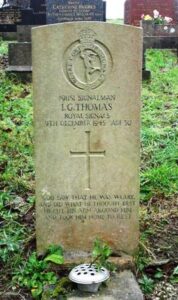
David Thursby, Lance Corporal, 3963595, Welch Regiment. David was born in the Lampeter area in 1919, the son of William and Amelia Thursby. The family then moved to Llanelli. David married Martha Howells, of New Street, Whitchurch in 1940. He served with the 4th Battalion, Welch Regiment, which was the local territorial infantry battalion. The battalion was attached to the 53rd (Welsh) Division, and remained on home service for the first years of the war, before landing in Normandy at the end of June 1944. It then took part in the break-out from the Normandy beach-head, and the fighting in the Bocage, before heading north through France into Belgium, crossing the frontier on 6 September 1944. On 9 September 1944 the battalion was carrying out a reconnaissance around Broechem when David was killed along with a comrade, Ronald Charles Bird, following a grenade attack by German troops. David was 25 years old, and is buried in Viersel Churchyard, Belgium. His widow, Martha, married Arthur John in 1951.
Raymond Frank Vidler, Flying Officer, 54005, Royal Air Force. Raymond was the son of Frank and Emily Vidler, and the husband of Beryl Mary Alice Vidler (nee George), of Solva. He served with 502 Squadron, Royal Air Force, which was a Coastal Command Squadron, equipped with the Halifax by January 1943. At 16.28 hours on 26 December 1944, Raymond’s Halifax, serial JP302, took off on an anti submarine flight. In the early hours of the night, she was reported as being attacked by four night fighters over the Skagerrak. No trace of the aeroplane and its crew of eight have ever been found. Raymond was 23 years old, and is commemorated on Panel 209 of the Runnymede Memorial, Surrey.
William Bartlett Williams, Private, 3977364, The Sherwood Foresters. William was the son of Albert Victor and Agnes Williams. He served with the 5th Battalion, Sherwood Foresters (Nottinghamshire and Derbyshire Regiment). The battalion fought with the 1st Army in the Tunisian campaign in 1943, before taking part in the Salerno Landings in Salerno in September 1943. Heavy fighting over the coming weeks whilst breaking out from Salerno caused chaos in the Allied advance. William was killed at some time between 13 and 15 October 1943. He was 22 years old, and is buried in Naples War Cemetery, Italy.